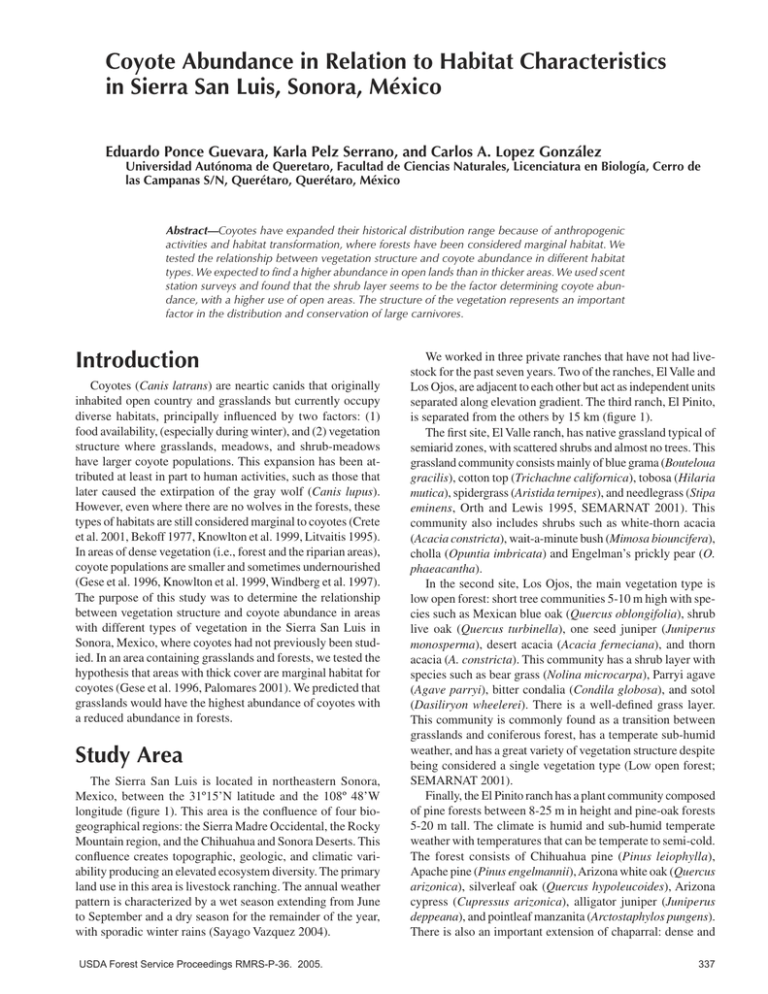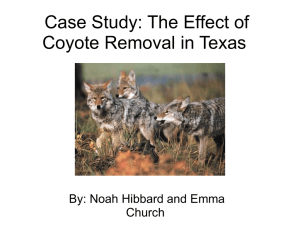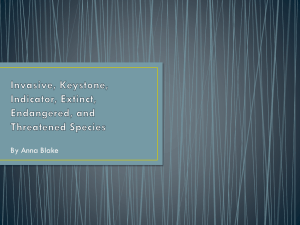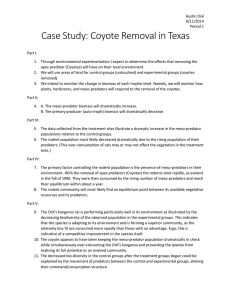Introduction
advertisement

Coyote Abundance in Relation to Habitat Characteristics in Sierra San Luis, Sonora, México Eduardo Ponce Guevara, Karla Pelz Serrano, and Carlos A. Lopez González Universidad Autónoma de Queretaro, Facultad de Ciencias Naturales, Licenciatura en Biología, Cerro de las Campanas S/N, Querétaro, Querétaro, México Abstract—Coyotes have expanded their historical distribution range because of anthropogenic activities and habitat transformation, where forests have been considered marginal habitat. We tested the relationship between vegetation structure and coyote abundance in different habitat types. We expected to find a higher abundance in open lands than in thicker areas. We used scent station surveys and found that the shrub layer seems to be the factor determining coyote abundance, with a higher use of open areas. The structure of the vegetation represents an important factor in the distribution and conservation of large carnivores. Introduction Coyotes (Canis latrans) are neartic canids that originally inhabited open country and grasslands but currently occupy diverse habitats, principally influenced by two factors: (1) food availability, (especially during winter), and (2) vegetation structure where grasslands, meadows, and shrub-meadows have larger coyote populations. This expansion has been attributed at least in part to human activities, such as those that later caused the extirpation of the gray wolf (Canis lupus). However, even where there are no wolves in the forests, these types of habitats are still considered marginal to coyotes (Crete et al. 2001, Bekoff 1977, Knowlton et al. 1999, Litvaitis 1995). In areas of dense vegetation (i.e., forest and the riparian areas), coyote populations are smaller and sometimes undernourished (Gese et al. 1996, Knowlton et al. 1999, Windberg et al. 1997). The purpose of this study was to determine the relationship between vegetation structure and coyote abundance in areas with different types of vegetation in the Sierra San Luis in Sonora, Mexico, where coyotes had not previously been studied. In an area containing grasslands and forests, we tested the hypothesis that areas with thick cover are marginal habitat for coyotes (Gese et al. 1996, Palomares 2001). We predicted that grasslands would have the highest abundance of coyotes with a reduced abundance in forests. Study Area The Sierra San Luis is located in northeastern Sonora, Mexico, between the 31º15’N latitude and the 108º 48’W longitude (figure 1). This area is the confluence of four biogeographical regions: the Sierra Madre Occidental, the Rocky Mountain region, and the Chihuahua and Sonora Deserts. This confluence creates topographic, geologic, and climatic variability producing an elevated ecosystem diversity. The primary land use in this area is livestock ranching. The annual weather pattern is characterized by a wet season extending from June to September and a dry season for the remainder of the year, with sporadic winter rains (Sayago Vazquez 2004). USDA Forest Service Proceedings RMRS-P-36. 2005. We worked in three private ranches that have not had livestock for the past seven years. Two of the ranches, El Valle and Los Ojos, are adjacent to each other but act as independent units separated along elevation gradient. The third ranch, El Pinito, is separated from the others by 15 km (figure 1). The first site, El Valle ranch, has native grassland typical of semiarid zones, with scattered shrubs and almost no trees. This grassland community consists mainly of blue grama (Bouteloua gracilis), cotton top (Trichachne californica), tobosa (Hilaria mutica), spidergrass (Aristida ternipes), and needlegrass (Stipa eminens, Orth and Lewis 1995, SEMARNAT 2001). This community also includes shrubs such as white-thorn acacia (Acacia constricta), wait-a-minute bush (Mimosa biouncifera), cholla (Opuntia imbricata) and Engelman’s prickly pear (O. phaeacantha). In the second site, Los Ojos, the main vegetation type is low open forest: short tree communities 5-10 m high with species such as Mexican blue oak (Quercus oblongifolia), shrub live oak (Quercus turbinella), one seed juniper (Juniperus monosperma), desert acacia (Acacia ferneciana), and thorn acacia (A. constricta). This community has a shrub layer with species such as bear grass (Nolina microcarpa), Parryi agave (Agave parryi), bitter condalia (Condila globosa), and sotol (Dasiliryon wheelerei). There is a well-defined grass layer. This community is commonly found as a transition between grasslands and coniferous forest, has a temperate sub-humid weather, and has a great variety of vegetation structure despite being considered a single vegetation type (Low open forest; SEMARNAT 2001). Finally, the El Pinito ranch has a plant community composed of pine forests between 8-25 m in height and pine-oak forests 5-20 m tall. The climate is humid and sub-humid temperate weather with temperatures that can be temperate to semi-cold. The forest consists of Chihuahua pine (Pinus leiophylla), Apache pine (Pinus engelmannii), Arizona white oak (Quercus arizonica), silverleaf oak (Quercus hypoleucoides), Arizona cypress (Cupressus arizonica), alligator juniper (Juniperus deppeana), and pointleaf manzanita (Arctostaphylos pungens). There is also an important extension of chaparral: dense and 337 109°00 ' 108°50 ' Arizona New Mexico 31°20' El Valle Figure 1—Study area located in the U.S.-Mexico borderland. Ranches are gray. Los Ojos Arizona New Mexico Chihuahua El Pinito Sonora Chihuahua 31°10' Sonora 3 0 3 6 Mi N 108°50 ' short vegetation associated with natural or induced fires, with a floristic composition formed principally by chamise (Adenostoma fasciculatum), manzanita (Artoctaphylos spp.), palmer oak (Quercus dinni), shrub live oak (Quercus turbinella), Parryi agave, alligator juniper (Juniperus deppeana), and beargrass (Nolina microcarpa), producing an open vegetal structure (Orth and Lewis 1995). Methodology Coyote Abundance We selected transects on which to place scent stations (Knowlton et al. 1999) to test our hypothesis. We established 3 transects of 3 km of length per ranch. Each transect consisted of ten scent stations with 0.3 km of separation between stations. Each scent station consisted of 1 m2 of sifted dirt with an attractant placed in the center (Canine Call and Bobcat Gland Lure from Minnesota Trapline Products). Scent stations were checked daily over 2 consecutive nights (hereafter, the sampling period) when weather permitted. The survey was repeated every 3 weeks from July 2003 to January 2004. We determined whether coyotes had visited the stations by examining the sifted dirt for the presence of tracks. We calculated the relative abundance of coyotes using a scent station index (SSI), where SSI was the total number of visits for each species divided by the total number of operable scent stations times 100 (Schauster et al. 2002, Wilson and Delahay 2001). We obtained a daily SSI per transect, in order to calculate an average (SD) for each sampling period, which we compared between ranches and seasons and used to characterize the population trend across specific microhabitat sites. 338 Microhabitat Use Characterization of microhabitat used by coyotes was determined at each scent station through the Point Quarter Sampling method (PQS). For each scent station, we placed a point 10 m away from to the station representing the center of four compass directions (N, S, E, W). We divided the sampling site into four quadrants representing the compass directions. In this area, we classified the structure of the vegetation into three classes: trees, shrubs, and grasses. For each individual plant, we determined the species and measured basal cover, aerial cover, height, and the point to plant distance (Brower et al. 1998). We obtained data for the following 11 variables: arboreal, shrub, and grass density; arboreal, shrub, and grass basal cover; arboreal and shrub aerial cover; and arboreal, shrub, and grass height. To determine if the microhabitat structure influenced coyote abundance, we used Principal Components Analysis to determine which variables represented the most variability (Garigol et al. 2000). Finally, we correlated coyote records and vegetation structure in order to detect a direct relation with any given variable. Results Coyote Abundance We obtained 110 coyote visits: 74 for El Valle, 35 records for Los Ojos, and one for El Pinito. But we did not find a significant difference between the seven surveys or between the two seasons. We detected a population trend to decrease in El Valle, whereas in Los Ojos we observed an increase. We had a single visit to El Pinito throughout the study (figures 2, 3, and 4). USDA Forest Service Proceedings RMRS-P-36. 2005. Vegetation Structure El Valle El Pinito Los Ojos 0,4 0,3 SSI 0,2 0,1 0 J A O S N D J Month Figure 2—Comparison of the Scent Station Index (SSI) in each of the three sites studied and in each month surveyed Wet season Dry season Discussion 0.3 0.25 0.2 SSI El Valle had lower tree and shrub density than the other two ranches but higher density of grasses. We found a significant difference between El Valle and El Pinito, namely in the grassland and the pine-oak forest; Los Ojos had an intermediate density between the other two areas (table 1). The Principal Components Analysis (hereafter PCA) was done in two parts, because the scale of variables varied greatly. The first part was with the tree and the shrub layers, and the second was with the grass layer. Ninety-two percent of the stations (n=83) were affected by 3 principal variables: the total density of shrubs, and the basal and aerial cover of shrubs (loadings of 0.573, 0.551, and 0.427, respectively). In general these stations were characterized as open ground. On the other hand, the remaining 7 stations (8%) were located in areas of dense vegetation. In the second analysis recording the grass layer (table 2), the majority of the stations were grouped by the PC2 reducing the three variables to only one: the height of the grass layer (loading of 0.998). Correlating the PCA results above with the coyote records, we found that 93% of the records were found in the big grouping of the PC2, and only the 7% were scattered (table 3). 0.15 0.1 0.05 0 El Valle Los Ojos El Pinito Locality Figure 3—Comparison of the Scent Station Index (SSI) in each weather season and in each of the three sites surveyed. � El Valle � Los Ojos � El Pinito 0,3 0,25 � � � 0,2 � � � � SSI 0,15 0,1 � � � 0,05 � J � A � � S � O � � N References � � D It seems clear that the forest in the Sierra San Luis might provide a marginal habitat for the coyotes, similar to other northern forests (Crete et al. 2001). The relatively low abundance of coyotes in the forest may be due in part to the increased presence of larger and competing predators (mountain lions and black bears) as a result of low human activities in the forest. Coyotes seem to be well-adapted to life in open lands, but in dense areas the shrub layer can play an important roll in the protection of prey species (Gese et al. 1996, Palomares 2001). Dense vegetation structure makes hunting for lagomorphs or rodents more difficult for coyotes, and the difficulty increases with shrubs such as the manzanita, sotol, and junipers that were found in our study areas and that can form an impenetrable layer for coyotes when the plants are sufficiently dense. In open habitats such as grasslands, coyote can detect, pursue, and capture prey with less energy costs. The chaparral in the Sierra San Luis, despite having an open structure, is generally surrounded by dense areas such as the forest, so it is possible that the coyotes within these areas were transient individuals. It is also possible that we did not find significant differences between the wet and dry seasons because 2003 was a year of El Niño, therefore the pattern of rains in Sonora exacerbated the already harsh drought. � J Month Figure 4—Correlation between the SSI of each site per month that shows the tendency of coyotes to use a type of habitat during some months. USDA Forest Service Proceedings RMRS-P-36. 2005. Bekoff, M. 1997. Canis latrans: Mammalian Species. The American Society of Mammalogists 79:1-9. Bounds, D. L. and W. W. Shaw 1994. Managing Coyotes in U. S. National Parks: Human-Coyote Interactions. Natural Areas Journal 14:279-284. Brower, J. E., J. H. Zar, and C. N. Von Ende 1998. Field and Laboratory Methods for General Ecology. Boston, MA: McGraw Hill. 339 Table 1—Vegetational structure in each locality. Average of the 11 variables measured in each vegetation type. Locality Vegetation type El Valle Los Ojos El Pinito El Pinito Natural grassland Open low forest Chaparral Pine-oak forest Total density (ind/100 m2) trees shrubs grasses 0.2 10.7 5.3 39.4 5.4 5.7 36.1 62.6 Basal cover (m2/100 m2) trees shrubs grasses 7094.3 799.4 504.8 698.6 0.0 0.8 0.6 3.1 1.4 2.5 5.0 3.0 283.5 53.8 34.5 39.8 Aerial cover (m2/100 m2) trees shrubs 0.2 13.6 5.2 39.5 2.6 25.3 24.9 68.9 Average height (m) arborial shrub grass 1.4 2.2 2.2 2.8 0.7 0.7 1.0 0.9 0.2 0.3 0.4 0.3 Coyote registries 74 35 1 0 Table 2—Values of the Principal Components Analysis of the grass layer. The PC2 is the principal where most stations are grouped. Significant values are in bold. Principal components EigenValue: 1.9723 Percent: 65.7436 Cum. percent: 65.7436 Eigenvectors: Grass layer Total density 0.70597 Basal cover 0.70628 Average height 0.05264 0.9974 33.2455 98.9892 0.0303 1.0108 100 -0.04316 -0.03129 0.99858 0.70692 -0.70724 0.0084 Table 3—Values of the Principal Components Analysis of the tree and shrub layer. The PC2 is the principal where most stations are grouped. Significant values are in bold. EigenValue: Percent: Cum. percent: Eigenvectors: 2.7957 34.9468 34.9468 1.8165 22.7064 57.6532 1.136 14.1998 71.853 Principal components 0.8508 0.6864 10.6351 8.5801 82.4881 91.0682 0.4253 5.3163 96.3845 0.2425 3.0309 99.4154 0.0468 0.5846 100 Total density Basal cover Aerial cover Average height 0.49559 0.56117 0.56992 0.22959 -0.22125 -0.13413 -0.15179 0.25432 -0.08377 0.03674 -0.01152 0.57098 Tree layer 0.13819 0.29366 -0.01241 -0.06629 0.07383 -0.00222 -0.44394 -0.4797 -0.10744 0.04754 0.04101 0.20777 0.74595 -0.50775 -0.27132 0.2928 0.15843 0.63335 -0.75582 -0.02245 Total density Basal cover Aerial cover Average height 0.18597 0.11497 0.11411 -0.0338 0.57343 0.42764 0.55196 0.17025 -0.17864 -0.30106 -0.09735 0.73038 Shrub layer -0.17448 0.63134 -0.20194 0.55534 -0.75635 0.27744 0.51012 -0.17912 -0.04263 0.11644 -0.05164 -0.09139 -0.01495 0.04171 0.00138 0.00566 Crete, M., J. P. Ouellet, J. P. Tremblay, and R. Arsenault 2001. Suitability of the forest landscape for coyotes in northeastern North America and its implications for coexistence with other carnivores. Ecoscience 8: 311-319. Gese, E. M., R. L Ruff, and R. L. Crabtree 1996. Intrinsic and extrinsic factors influencing coyote predation of small mammals in Yellowstone National Park. Canadian Journal of Zoology 74:784-197. Knowlton, F. F., E. M. Gese, and M. M. Jaeger 1999. Coyote depredation control: An interface between biology and management. Journal of Range Management 54:398-412. Litvaitis, J. A. 1995. Niche relation Between Coyotes and Sympatric Carnivora. Chapter 5, in Eastern Coyote, the history of it success, ed. Parker G., Nimbus publishing, LTD, 254 pp. Luna, Soria. H., Pelz, Serrano K., Ponce, Guevara E. Sierra, Corona R. and López, Gonzáles C. 2002. Contribución al listado faunistico de las Sierras Zetasora y San Luis, Sonora. XIX Simposio Sobre Fauna Silvestre: Memorias, Facultad de Medicina Veterinaria y Zootecnia de la UNAM. M. C. Garigol, S. Cushman, and S. Stafford 2000. Multivariate Statics for Wildlife and Ecology Research. Springer Press. 283 p. 340 -0.01104 -0.4716 0.6076 0.29588 Mech, L. D. 1974. Canis lupus: Mammalian Species. The American Society of Mammalogists 37:1-6. Orth, E. A., and E. E. Lewis. 1995. A field guide to the plants of Arizona. Bozeman, MT: Falcon Press. 347 p. Palomares, F. 2001. Vegetation structure and prey abundance requirements of the Iberian lynx: implications for the design of reserves and corridors. Journal of Applied Ecology 38:9-18. Sayago Vazquez, I. A. 2004. Uso de habitat del Oso negro (Ursus americanus) en la Sierra de San Luis, Sonora, Mexico. Bachelor’s thesis FES-Iztacala, UNAM. Mexico. Schauster, E. R., E. M. Gese, and A. M. Kitchen 2002. An evaluation of survey methods for monitoring swift fox abundance. Wildlife Society Bulletin 30:464-477. SEMARNAT 2001. Inventario Nacional Forestal, Anexo VI.7; Diccionario del Inventario Nacional Forestal. Investigaciones Geográficas, Boletín del Instituto de Geografía, UNAM. Windberg, L. A., S. M. Ebbert, and B. T. Kelly 1997. Population Characteristics of Coyotes (Canis latrans) in the Northern Chihuahuan Desert of New Mexico. The American Midland Naturalist 138:197-207. Wilson, G. J., and R. J. Delahay 2001. A review methods to estimate the abundance of terrestrial carnivores using field signs and observations. Wildlife Research 28:151-164. USDA Forest Service Proceedings RMRS-P-36. 2005.








